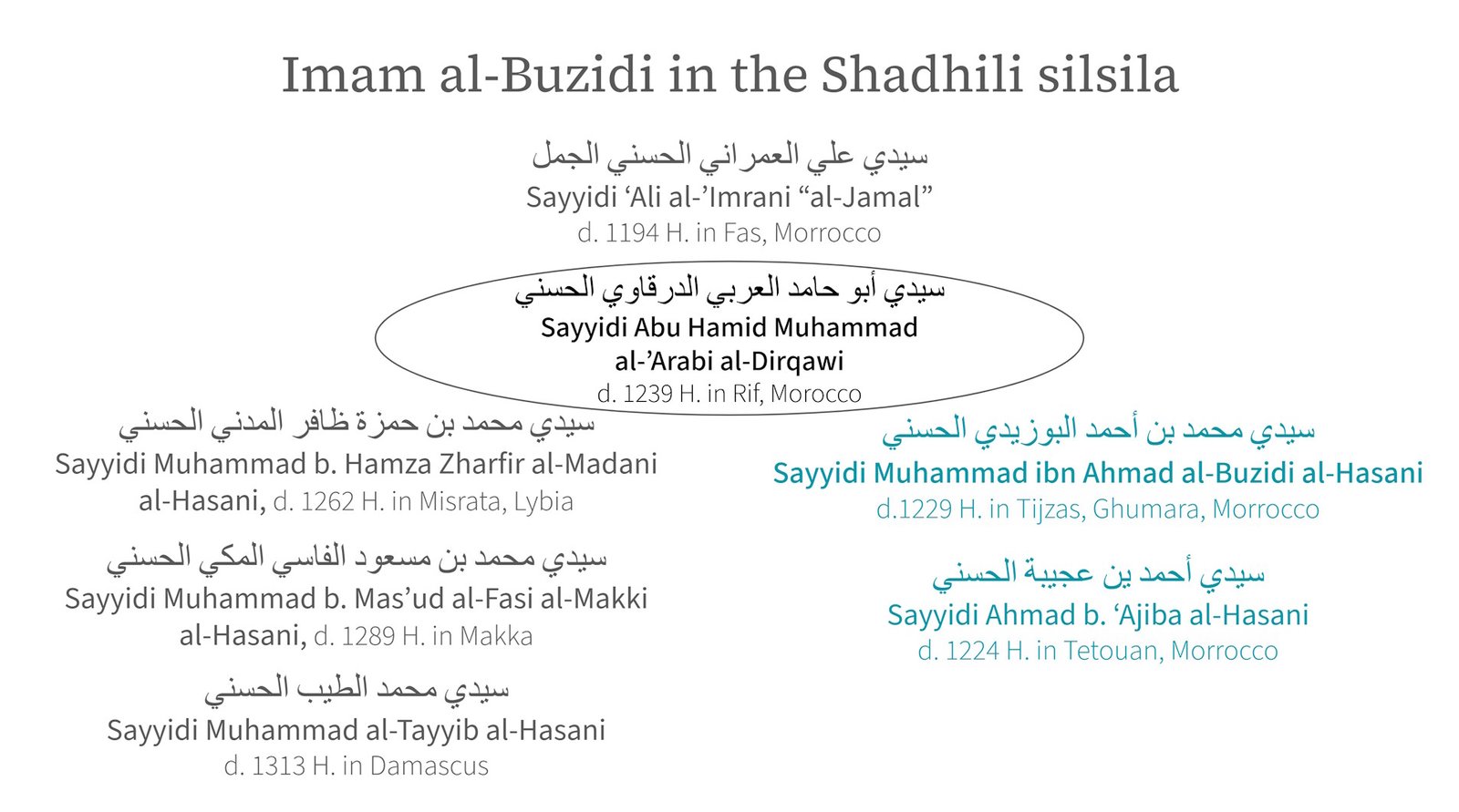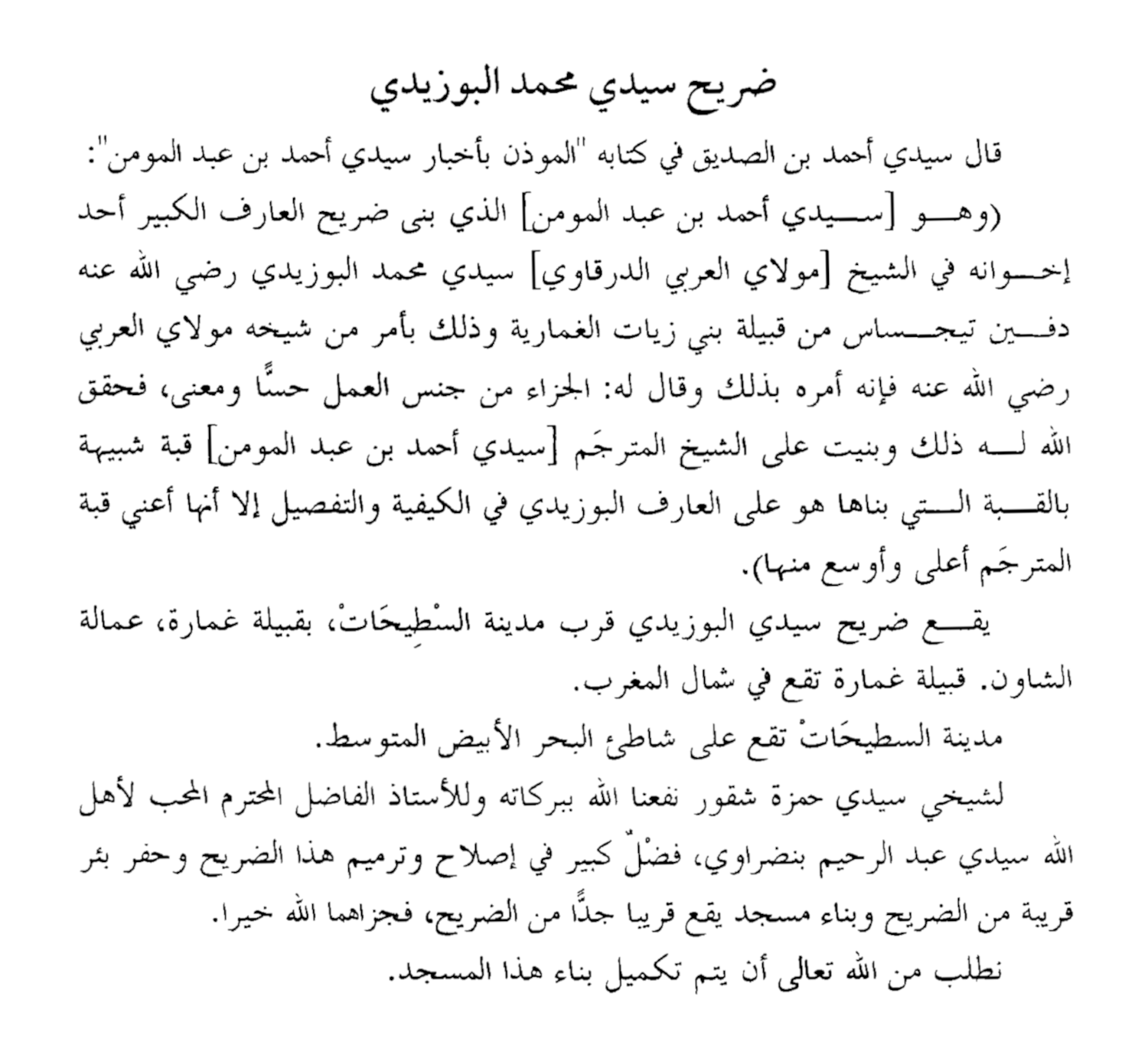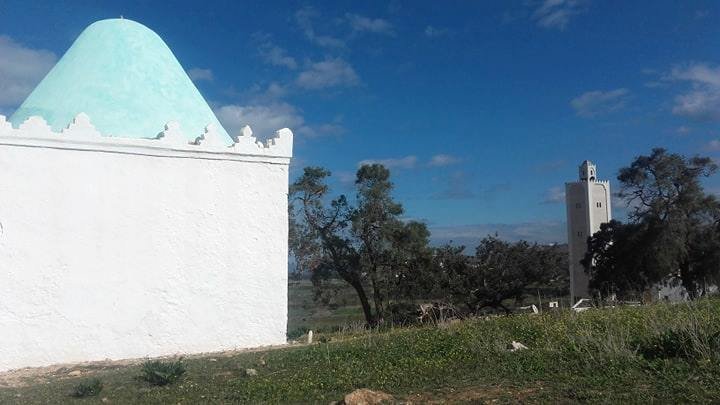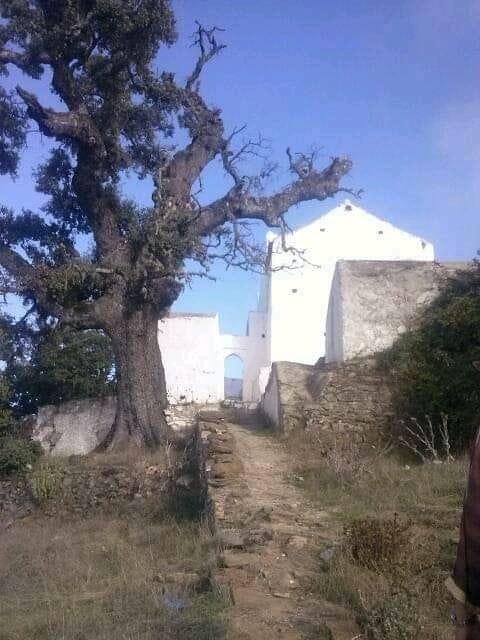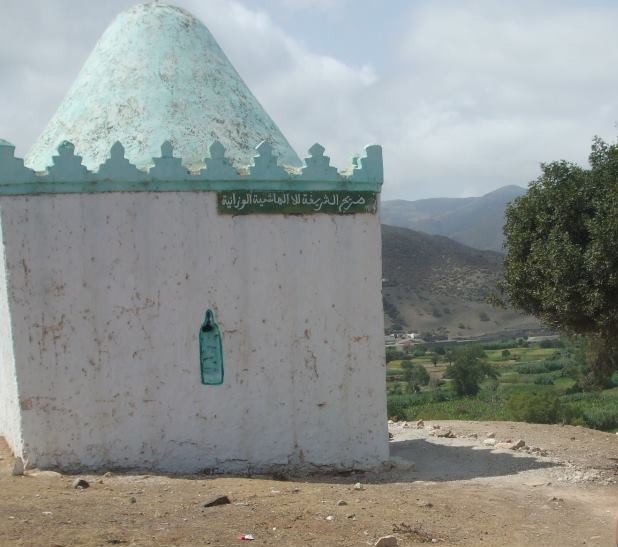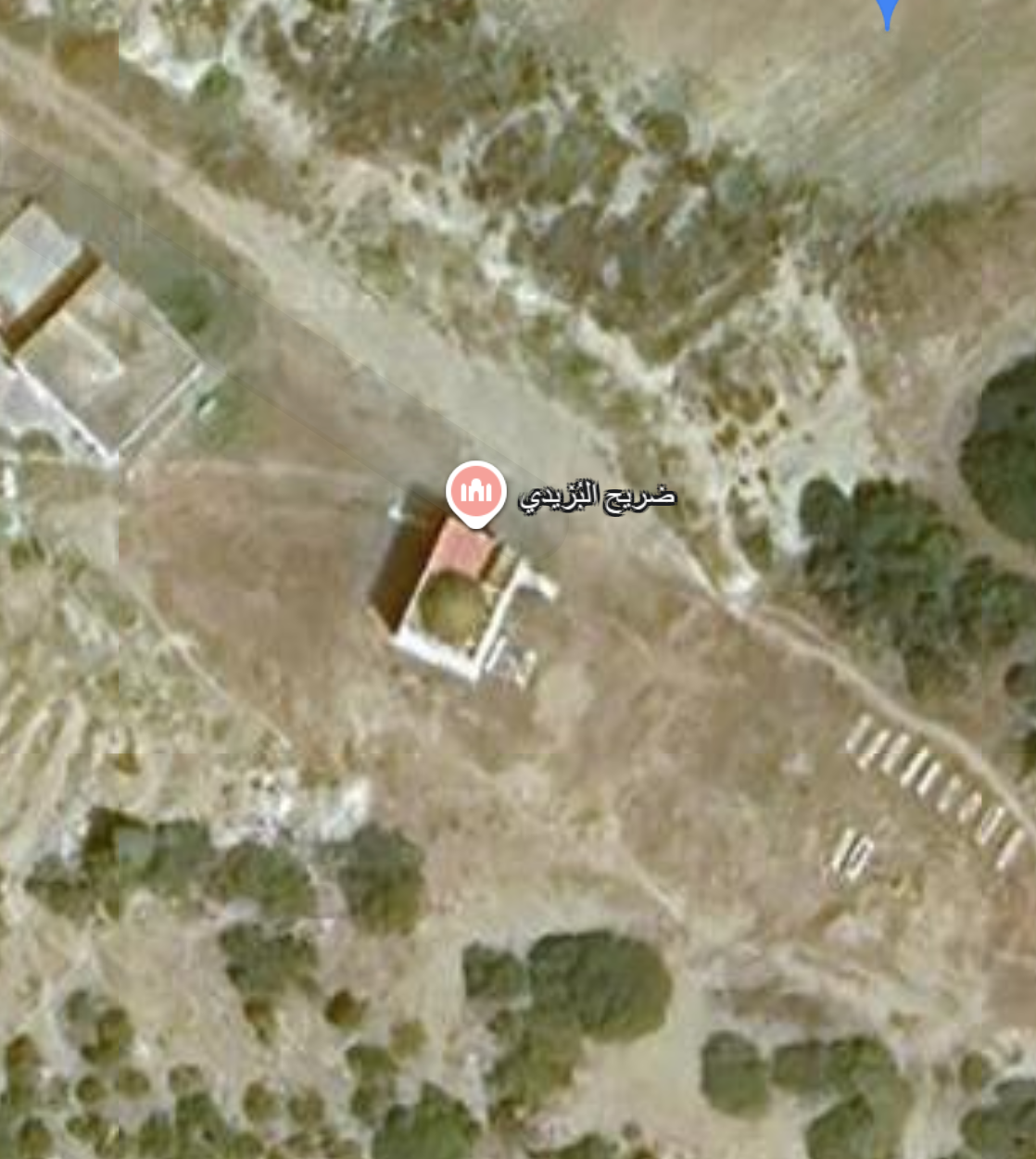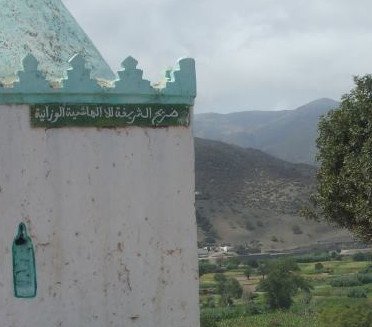Bio: Sh. Muhammad ibn Ahmad al-Buzidi | الشيخ محمد بن أحمد البوزيدي
Sayyidi Sh. Muhammad Ibn Ahmad Al-Buzidi
سيدي الشيخ محمد بن أحمد البوزيديd.1229 H.
Intro
Shaykh Ahmad ibn ´Ajiba was his student and khalifa
Author of Al-Adab al-Mardiyya
Praise
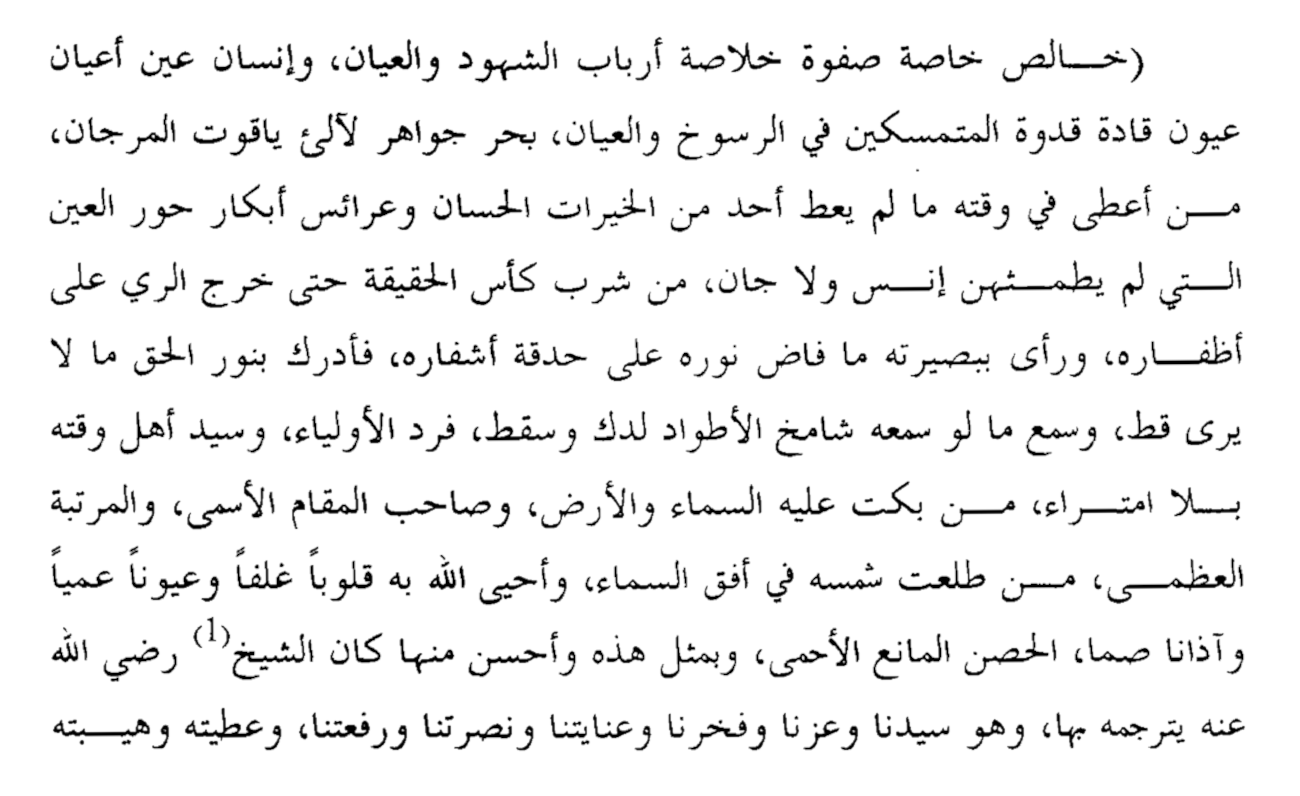
The purest of the elect of the essence of the elite of the Masters of witnessing and manifest seeing; the core (pupil of the eye) of the people of distinction from amongst the prime of leaders of the paragons of the most well-established of the solidly rooted and accomplished ones; the ocean of jewels of pearls of the most precious of corals; who was granted in his time more than is granted to any of the beautiful, virtuous women of Paradise, or the bridegrooms of the virgins of perfect heavenly beauty that neither man nor jinn has touched; who drank from the goblet of divine realities until its moisture came out from his fingers; and he saw with his inner eye things, the light of which flooded through the pupils of his eyes over his eyelashes. Thus he perceived, by the light of the Real, what had never been seen before, and he heard things by which the loftiest of the poles, if they heard it, would be smashed to the ground. Without any doubt, he was the unique amongst the saints and master of the folk of his time, over whom heaven and earth cried; who held the highest maqam and the furthest rank; whose sun rose on the horizon of the sky, and through whom Allah gave life to closed hearts and blind eyes and deaf ears; the protecting and most shielded fortress…
In words like these, and even more beautiful, would the Shaykh [Imam Al-Dirqawi], may Allah be pleased with him describe Abu ‘Abd Allah, my master Muhammad ibn Ahmad al-Buzidi al-Gumari as-Salmani al-Hasani – may Allah be pleased with him.
______________
English
The Life of Imam Al-Būzīdī [1]
1. His name and provenance
2. Childhood and learning
3. In search of a spiritual master
4. The early time with Imam Al-Dirqawi – meeting Imam Al-Dirqawi
5. Reviving the Sufi Path among Banu Zarwal
6. His authorization and rank
7. Return to Ghumara
8. Ibn ʿAjība: his disciple and khalifa
9. The influence of Al-Ādāb al-mardiyya
10. His passing
11. Three contemporary giants
12. Sources of his biography
His full name was Abū ʿAbd Allāh Muḥammad b. Aḥmad al-Būzīdī al-Sharīf al-Ḥasanī al-Salmānī al-Ghumārī. He was born and raised in the Banū Salmān tribe in the Ghumāra region of Morocco. Because of his tribal affiliation he was known as Salmānī, after his birthplace as Ghumārī, and due to his descent from the Prophet ﷺ he bore the titles al-Sharīf and al-Ḥasanī. Neither his exact date of birth nor sufficient information about his family are available.
^
Imam Al-Būzīdī grew up in a family environment that was deeply immersed in the Sufi way of life. From childhood and youth, he dedicated himself to worship, leading an ascetic, reclusive life focused on piety and spiritual struggle. He acquired the basic principles of religion in his childhood but did not pursue further studies. From Al-Būzīdī’s own words—“Never in my life have I sat in a scholarly circle”—it may be understood that he was ummī (illiterate), i.e. he did not know how to write, and he composed his works through dictation. However, he recited the Qurʾān with precision (itqān). Beyond that, his knowledge was divinely bestowed.
^
For many years he wandered in the mountains and entered retreats in caves. His last stop before entering the Sufi path was a hermitage near Tangier, on the coast of Sīdī Qāsim b. Mawlānā Idrīs. During this period, while in search of a spiritual master, Al-Būzīdī attended the gathering of a saint there. Following that saint’s advice, he set out for Fez in search of al-ʿArabī al-Dirqāwī.
In Al-Ādāb al-mardiyya, Imam Al-Būzīdī describes his encounter with Imam Al-Dirqāwī as follows:
“I, the servant of Allah, came to him with the permission of one of the saints of Allah. This was after my heart had become attached to meeting the great pole (quṭb), and I was invoking Allah to meet him in almost every prostration, while, praise be to Allah, I was engaged in dhikr, in sending blessings upon our Master, our Liege-Lord, the Messenger of Allah—may Allah send blessings and peace upon him—in reciting the Book of Allah, and in worship through seclusion, prayer, vigil, and fasting. That saint loved me deeply, but I was not content with him as my shaykh, and he saw that my spiritual aspiration was attached to another. Since people were saying, ‘the great pole is there,’ I wanted to go to Mecca. When that saint learned of my intention, he said, ‘My brother, he is in Fez; you must find him, he is so-and-so,’ I hastened towards him, arrived in Fez, and inquired about him, but found nothing until I reached the door of his house. I knocked, and the Shaykh — may God be pleased with him—came out immediately, and I kissed his blessed hands.
He asked me, ‘Where have you come from?’
I replied, ‘My master, from the sea.’
‘From which sea?’
‘From Mount Ashkār.’
‘What do you seek from us?’
‘By your blessing, I wish to become a sultan in the Hereafter.’
He said, ‘We have granted you authority in this world and the Hereafter.’
He immediately invited me into his house and said to me, ‘Enter, I would never leave someone like you outside the house.’ He took me in, greeted me, seated me on the prayer rug in his retreat, offered me food and drink, and addressed me with his advice.”
Alongside this account, which presents al-Būzīdī’s meeting with his shaykh as occurring on the advice of a saint, ʿAbd al-Kabīr b. al-Majdhūb transmits another version. According to him, while Būzīdī was engaged in retreat in the mountains, he encountered a group of devout worshippers in a cave. He joined them in worship and discussion, and when he heard things he had never heard before, he asked them who their shaykh was. They replied:
“We are a group of believing jinn, and our shaykh is in Fez, his name is Mawlāy al-ʿArabī. We attend his gatherings, but none other than our shaykh can see us. When he addresses people, he raises his head towards us so that we may hear his words. We have a custom with him: whenever he enters the mosque, he leaves his shoes facing inward; when he wishes to leave, we prepare them for him, and in this way we welcome him.”
According to al-Majdhūb, this incident prompted Shaykh al-Būzīdī to go to Fez, where he found Imam Al-Dirqāwī.
^
Al-Būzīdī’s meeting with Shaykh al-Dirqāwī, marking his entrance into the Sufi path, took place in 1196 H. This encounter coincided with a period of leadership disputes in the ṭarīqa following the passing of Shaykh ʿAlī al-Jamal al-ʿAmrānī (d. 1193 H.) Although Shaykh ʿAlī had appointed al-Dirqāwī as his successor, the disciples of the ṭarīqa did not recognize al-Dirqāwī’s authority, and he was abandoned. In this period, al-Būzīdī was the first to pledge himself to him. For some time he was the only resident of the lodge, until the number of disciples gradually increased. Imam Al-Būzīdī himself recalls:
“At that time, no one knew us except a few brothers from the people of Fez, who knew their shaykh [i.e., ʿAlī al-Jamal]. They would meet us by day and return to their homes by night. As for me, I spent many days alone in the zawiya, until Allah granted us brothers and lovers. We were continually occupied with dhikr and discussion, to the extent that on some days we could hardly distinguish night from day except by the calls to prayer from the minarets.”
As the sole disciple in the shaykh’s lodge, obviously Imam Al-Būzīdī was subject to special treatment and an intense process of spiritual training. As part of the practices in his spiritual journey (sulūk) and the order’s discipline, he engaged in begging, together with his shaykh:
“(Shaykh al-Dirqāwī)—may Allah be pleased with him—would meet me at the courtyard of Qays near Fez, after the ʿAṣr prayer. In order to humble ourselves, we would go out among people we knew and beg from the shops. When we reunited in the Qays courtyard in Fez, we would buy something to eat. The shaykh would go to the sellers of bread, onions, and suchlike, buy something for four or six fulūs, and always pay more than its price. Our days passed in this manner. The shaykh taught me generosity, good character, asceticism, and more.”
Ibn ʿAjība attributes the revival and expansion of the ṭarīqa to the da’wa of Imam Al-Dirqāwī and Imam Al-Būzīdī, describing it as follows:
“Muḥaqqiq Sufis (those who have attained the truth) also appeared in our time. Praise be to Allah, after our shaykh Muḥammad al-Būzīdī al-Ḥasanī came to Banī Zarwāl with his shaykh Mawlāy al-ʿArabī al-Dirqāwī, a great spread in Sufism occurred along with us. The ocean of their spirituality surged and overflowed, and Sufism spread to other regions as well, so much so that it became possible to find realized ʿārifūn and awliyāʾ in every city and tribe, except for a few places that remained distant from them. These two men revived the extinguished ṭarīqa, they made the sun of the extinguished ḥaqīqa shine again. The remembrance of Allah began to be performed everywhere. All the servants who followed them turned to Allah. May Allah, exalted is He, grant great rewards on behalf of the Muslims to these two men. Truly Allah, exalted is He, fulfilled through these Sufis the words of the Messenger of Allah, ‘The best of my community is its first generation and its last generation.’”
While still residing at Imam al-Dirqāwī’s zawiya, Shaykh al-Būzīdī was holding gatherings amongst Banū Zarwāl, which indicates that he had already at that time been authorized to represent his shaykh. During this period he is also known to have admitted disciples into the tariqa.
Imam Al-Dirqāwī affirmed Būzīdī’s authority within the order on various occasions. In this regard, he wrote several letters to his disciples to announce that he had granted Imam Al-Būzīdī authorization and to ensure recognition of his authority in the ṭarīqa:
“To all our brothers in Fez, may the mercy and blessing of Allah be upon you. We have granted authorization (ijāza) to Muḥammad b. Aḥmad al-Būzīdī al-Sharīf. Show him respect and reverence, honor him, visit him, and listen to him, for he is our deputy both during our life and after our death. By God, I have not known anyone among the fuqara of this time who knows the Sufi path as well as he does.”
In addition to Imam Al-Dirqāwī’s own words, the testimonies of other Sufis of the period confirm that Imam Al-Būzīdī’s spiritual authority was acknowledged by his contemporaries. One ne account reports that Imam Al-Būzīdī met and conversed with Sayyiduna al-Khiḍr – indeed a powerful indication of his spiritual rank.
After spending sixteen years in the zawiya of Imam Al-Dirqāwī, he returned to the Banū Salmān tribe in Ghumāra. With the authorization of Imam Al-Dirqāwī, he opened his own lodge there in 1212 H. and he continued his guidance until his death seventeen years later. His activities spread his name beyond Ghumāra to distant lands, and as a result of his influence within the Dirqāwiyy tariqa, a branch of the order came to be known as the Būzīdiyya.
^
The influence of Imam Al-Būzīdī in the ṭarīqa continued through his khalīfa Ibn ʿAjība, who entered the ṭarīqa directly through Imam Al-Būzīdī, completed his spiritual journey under his supervision, and received his authorization for spiritual guidance (ijāza) from him. At the request of Imam Al-Būzīdī, Ibn ʿAjība played an active role in bringing the ṭarīqa to different tribes through his da’wa, and he also sustained his influence through his writings.
^
The place and influence of Imam Al-Būzīdī as a representative of the school also continued through his work Al-Ādāb al-mardiyya li-sālik ṭarīq al-ṣūfiyya. The influence of this work on Ibn ʿAjība’s writings can be noticed in his sufi Qurʾānic commentary Al-Baḥr al-madīd, where Ibn ʿAjība benefited from the symbolic interpretations in Al-Ādāb al-mardiyya and from the points concerning the etiquette of the disciple.
^
Imam Al-Būzīdī remained an active representative of the Shādhilī tariqa until his death, spreading al-Dirqāwī’s teachings. However, since he passed away before al-Dirqāwī, he did not live to carry his shaykh’s spiritual legacy after him.
Imam Al-Būzīdī died on 10 Muḥarram 1229 H. (2 January 1814 CE) in his lodge on the coast of Ticsās in Ghumāra, where he was buried. Over his grave, a mausoleum was built by his disciple Aḥmad b. ʿAbd al-Muʾmin at the request of Imam Al-Dirqāwī. Later, members of the Dirqāwiyya dug a well and constructed a mosque near the mausoleum.
Commemorative ceremonies (mawasim) have been held annually at Imam Al-Būzīdī’s burial place, however they were interrupted for long periods. During such ceremonies, sacrifices are offered near the mosque by the mausoleum, Sūrat Yāsīn and laudatory odes were recited, prayers are offered, and ḥaḍra is performed. The records on these ceremonies extend up to 2003, however, their current state is unknown.
^
Imam Al-Būzīdī is among the first representatives of the Shādhilī-Dirqāwī school. Being the first khalīfa of Imam Al-Darqāwī, Imam Al-Būzīdī received the duty of spiritual guidance in 1212 H. and, with his shaykh’s direction, returned to Ghumāra and opened his own zāwiya. For seventeen years, until his death in 1229 H., he continued his activities of spiritual guidance as an “independent shaykh” at the head of his zāwiya. Thus, Imam Al-Būzīdī became an influential figure who spread the teachings of Imam Al-Dirqāwī while the latter was still alive.
Nevertheless, since the Imams al-Būzīdī and al-Dirqāwī lived during the same period, the perception has emerged that he took the ṭarīqa from both shaykhs, and thus Imam Al-Būzīdī has not been portrayed in the history of the Darqāwiyya as an independent and influential spiritual master. Clarifying the role of Imam Al-Būzīdī in the spiritual journey (sulūk) of Ibn ʿAjība allows us to understand Imam Al-Būzīdī correctly as a spiritual master without diminishing the importance of Imam Al-Darqāwī. Undoubtedly, during the period in which Imam Al-Būzīdī was active as a shaykh, Imam Al-Darqāwī also maintained communication with both Imam Al-Būzīdī and his disciples, continuing to provide them with guidance. However, as Ibn ʿAjība clearly states in his autobiographical work Al-Fahrasah, he entered the ṭarīqa directly through Imam Al-Būzīdī, completed his spiritual journey under his supervision, and received his authorization for spiritual guidance (ijāza) from him.
In short, as the first khalīfa of Imam Al-Darqāwī and among the first representatives of the Shādhilī-Darqāwī school, Imam Al-Būzīdī contributed to the spread of the ṭarīqa both through the activities he carried out in his zāwiya and through his works. However, since he passed away ten years before his shaykh, he did not have the opportunity to continue his spiritual legacy after his shaykh. It can be said that this caused Imam Al-Būzīdī’s name to be less well known compared to the other representatives of the school.
There are only limited sources that comprehensively deal with his biography. His work Al-Ādāb al-mardiyya and the writings of his student Ibn ʿAjība contain anecdotes that allow us to reconstruct only the part of his life following his affiliation with the Shadhili ṭarīqa. Among the sources that discuss his life more fully, the most prominent is his contemporary Muʿaskarī’s Kanz al-asrār, followed by the modern work of Talīdī, al-Muṭrib bi-mashāhīr awliyāʾ al-Maghrib. Muʿaskarī’s information is particularly important because he lived during the same period, provided detailed accounts, and served as a source for subsequent biographies.
^
___________
Kızılkaya, Zeyneb Nur. “Bûzîdî ve el-Âdâbu’l-mardiyye’si: Literatür ve Kavram İncelemesi.” Master’s Thesis, Marmara University, Istanbul, 2021.
^
عربي
رضي الله عنه وأرضاه وجعل جنةَ النظر والمعارفِ مثواه
ترجمته وبعض آثاره
from the book of Dr. Tilsamani
Biography of Imam Al-Buzidi
Tomb of Imam Al-Buzidi
Letters of Imam Al-Dirqawi about Imam Al-Buzidi
Letters by Imam Al-Buzidi
Al-Adab al-Mardiyya
The Book
The Fihris
Meeting Imam Dirqawi
Section from “Al-Adab al-Maridyya” on how Sh. al-Buzidi met his shaykh, Imam Al-Dirqawi
PDF: View | Download
See also English bio tab
 Loading...
Loading...
Burial Place
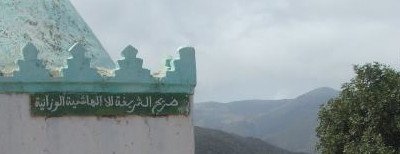
Tomb of Imam Al-Buzidi: PDF
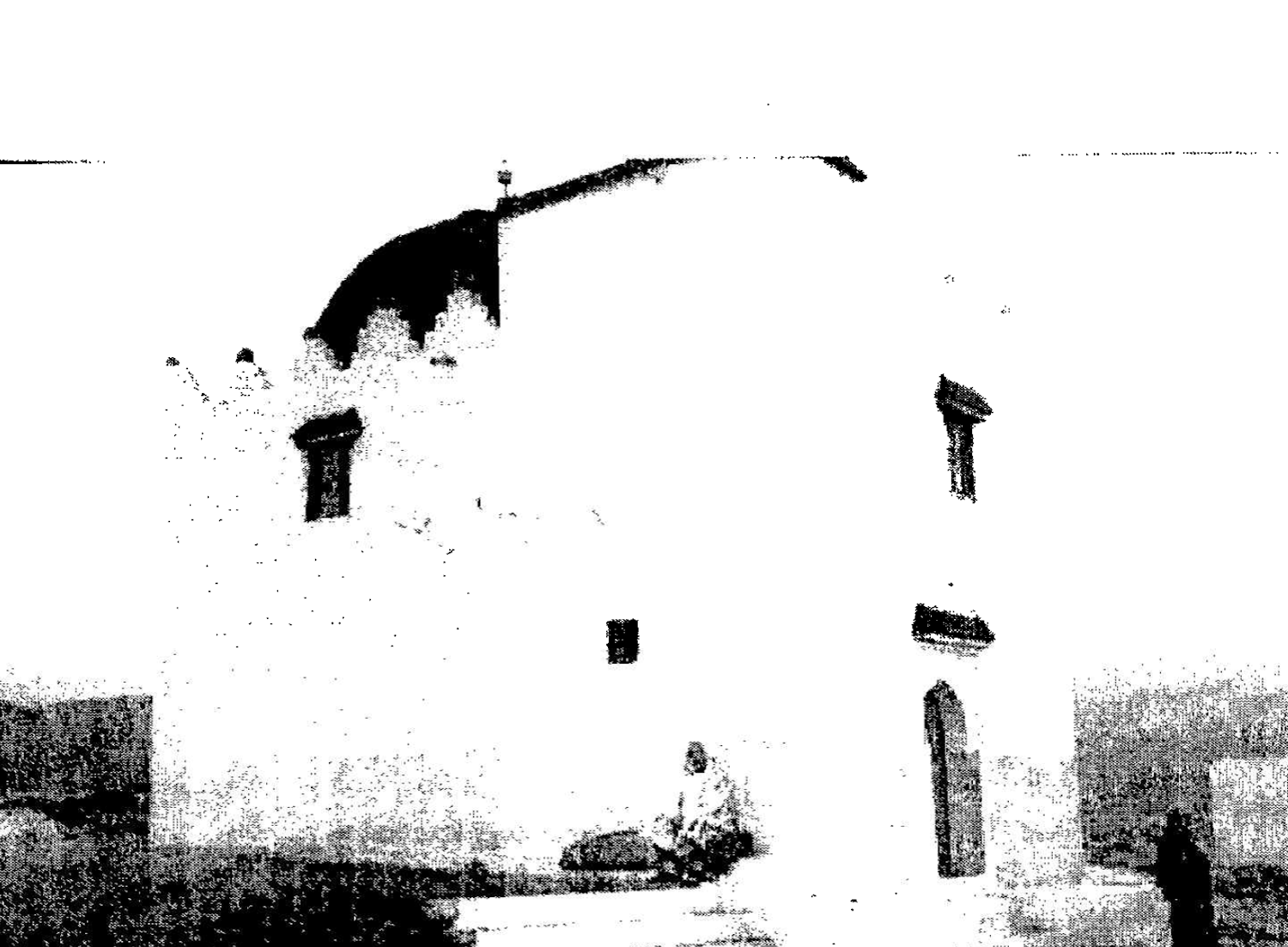
محمد بن أحمد البوزيدي
في ليلة الأحد تاسع محرم (عام تسعة وعشرين ومائتين وألف) توفي محمد بن أحمد البوزيدي الغماري الحسني. كان صوفيا مطلعا خيرا دينا من أكبر تلامذة الشيخ العربي الدرقاوي، له تأليف في علم التصوف وطريق القوم على طريقة الإملاء، لأنه كان أميا لا يحسن الكتابة. دفن ببلده وجعلت عليه قبة.
—
إتحاف المطالع بوفيات أعلام القرن الثالث عشر والرابع- لعبد السلام بن عبد القادر ابن سودة.
توفي رضي الله عنه فاتح عام تسعة وعشرين ومائة وألف بقبيلة بني زيات الغمارية بتيجيساس قريبا من ساحل البحر الأبيض، وقد وهم من قال توفي ودفن ببني سلمان
Imam Al-Buzidi is buried in Ghumara, in his zawiya on the Tijsas seaside. There is a mosque near his tomb and a well. There has been annual celebrations at his tomb until 2003.
It is said that Imam Al Buzidi died and was buried in Tijisas.
